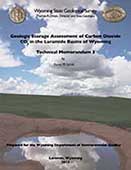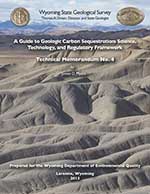Geologic CO2 Storage in Wyoming
Wyoming has taken an active approach toward research into the viability of long-term geologic carbon dioxide (CO2) storage. Research for carbon capture technology is ongoing at the University of Wyoming:
the Center for Economic Geology Research studies CO2 storage in the structure of the earth’s crust, and the Enhanced Oil Recovery Institute evaluates CO2 storage when the chemical compound is used to enhance oil recovery from the state’s oil reservoirs.
These entities, among others, are striving to maintain coal as a viable resource in Wyoming. Wyoming’s abundant coal resources provide 7 percent of the energy produced in the United States, yet burning coal releases CO2 into the atmosphere. As greenhouse gas emissions face increasing regulatory pressure and public scrutiny, developing the technology to capture, compress, and store CO2 emissions in geologic traps may be fundamental to Wyoming’s future energy economy.
Geologic Storage Assessment of Carbon Dioxide (CO2) in the Laramide Basins of Wyoming

The subject of this investigation is the potential for long-term geologic storage of anthropogenic CO2 within the Laramide basins of Wyoming. Laramide basins are fault-bounded basins
that formed between basement-cored mountain ranges during the Late Cretaceous to Early Eocene Laramide orogeny (~80–55 Ma). These basins formed by basement-rooted reverse faults with as much
as tens of kilometers of vertical offset. Laramide basins are found from northern Mexico through Canada. The Laramide basins evaluated for this study include the Greater Green River, Wind River,
Bighorn, Powder River, Hanna, and Denver basins. The results are summarized in Technical Memorandum 3.
Download the Geologic Storage Assesment of Carbon Dioxide (CO2) in the Laramide Basins of Wyoming, Technical Memorandum 3.
Understanding the EPA’s Carbon Sequestration Regulations

Carbon dioxide capture and geologic storage has not yet occurred at an industrial scale in the United States or elsewhere. However, with the potential for future geologic storage, the U.S. Environmental
Protection Agency (EPA) and the Wyoming Department of Environmental Quality (DEQ), under the guidelines of the Safe Drinking Water Act’s Underground Injection Control program, have developed regulations
for safely storing CO2 deep underground in geologic formations. In particular, Class VI wells have been designated as a new well class for CO2 sequestration.
Download the Understanding EPA’s Carbon Sequestration Regulations, Technical Memorandum 4.